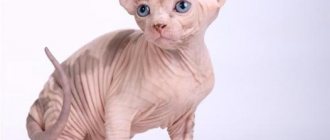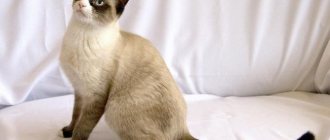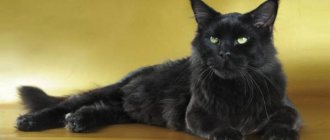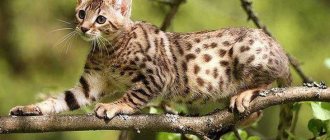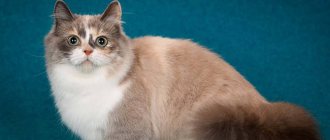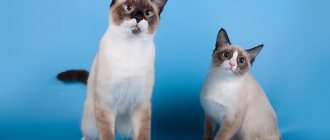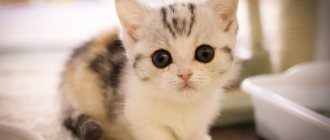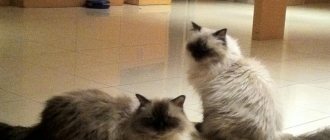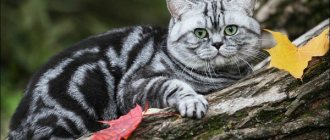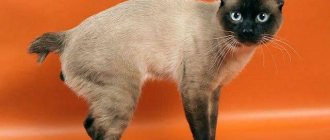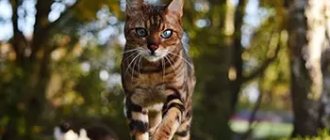Origin story
Agile shaggy cats - “vana katu” - were first seen near Lake Van: this body of water was considered part of ancient Armenia, and later passed to the Ottomans.
A Turkish legend says: when the devil decided to destroy Noah's ark, he threw a mouse into it so that it would gnaw a hole in its walls. But God, wanting to save humanity, sent her white cat to be destroyed. The furry huntress successfully completed her job, and as a reward, God touched her with his hand. The red marks on her fur are called God's tracks.
Merchants and crusaders exported cats to other continents. They did not gain much popularity there, but received a new name - ring-tailed cats. They became the ancestors of the modern Turkish Vans.
In the 50s, British journalist Laura Lushington took a pair of unusually beautiful kittens: a male and a female, from Turkish territory. They gave birth, and by 1994 these cats were recognized by most major cat fancier organizations. The name "Turkish cat" was changed to "Turkish van".
Turkey, which for a long time refused to recognize the uniqueness of its charges, eventually radically changed the principle, introduced a ban on the export of cats and declared them a national treasure. It is worth saying that only cats with heterochromia and snow-white fur deserve such a reverent attitude. But felinological organizations treat them in two ways.
Interesting facts about the Turkish Van breed
- Turkish Van wool has unique dust-repellent and water-repellent properties. In addition, it is softer than fluffy cashmere yarn.
- Many owners note that the Vanir’s favorite game is catching streams of water from a slightly open tap. On a hot summer day, they will be happy to stand under a cool stream, and at night they will go to sleep in a damp sink
- A monotonous life within four walls is unacceptable for these cats. They love walks, travel, new experiences. The owner will have to often play with the cat and replace his torn and tired toys.
Van cat in literature and fine arts
Van cats are a cultural symbol of the Armenian, Turkish and Kurdish peoples - those who inhabited the coast of Lake Van in different periods of time. Images of these animals can still be found on the products of Armenian craftsmen (carpets, dishes, clothes). Mention of them is present in works, films and paintings:
- Ancient Armenian work “The Birth of Vahagn”.
- Axel Bakunts, story “In a Dark Gorge” (1927).
- Vrtanes Papazyan, story “Vana Katu”.
- Hakob Melika-Hakopyan, novel “Diary of the Cross Thief” (1890).
- Roger Tabor, documentary "Cats" (1999).
- Antoine Jean Bayle, French artist, painting “Girl with a White Cat” (late 18th-early 19th centuries).
In the Turkish (and formerly Armenian) city of Van, a monument dedicated to van kedesi, a snow-white cat with different eyes, was erected.
Standards
Cats of this breed cannot be called miniature: the average weight of the animal is 6-9 kg. Moreover, males are outwardly larger and more massive than females.
| Standard | Description |
| Scull | Wedge-shaped, with minimal muzzle definition and a clearly defined chin. |
| Ears | Large, with a wide base and rounded tips. Both inside and outside the auricle is densely pubescent. |
| Nose | Small, the tip is colored soft pink. |
| Eyes | Large, open, slightly elongated. The color of the iris is blue or dark yellow. Different colored eyes are not considered a defect. |
| Torso | Small but strong, with a well-developed muscular corset, massive chest and strong neck. |
| Knees | Medium length, paws rounded, small. The pads are pale pink. |
| Tail | Reminiscent of a brush: covered with semi-long, thin hair. In summer the pubescence is quite sparse, but in winter it looks much more impressive and resembles a luxurious fan. |
| Wool | The undercoat is completely absent, and the coat itself is silky to the touch, semi-long. Longer on the hips and tail, shorter in the neck and shoulders. Summer cat “clothes” are light and airy, winter ones are heavier and thicker. |
These signs lead to disqualification:
- a clear “stop” on the bridge of the nose,
- no spots on the head,
- too many colored marks (more than 15% on the entire body),
- flat chest, underdeveloped fingers,
- creases and loops on the tail.
The cost of individuals of this breed is high, since this breed is rare. There is only one nursery in Russia, the rest are only abroad (in Canada, Turkey, USA). The price for 1 kitten ranges from 50,000 to 100,000 rubles. It is dangerous to buy animals from private breeders: you can run into unscrupulous sellers.
Description of the Van cat
The main distinguishing feature of the Turkish Van is the characteristic Van color, in which the main part of the body (at least 80%) is snow-white, and the tail and markings on the head are the color of “Armenian apricot” or the sunrise and sunset on Lake Van. Some felinological associations today also recognize completely white cats, considering them mestizos obtained as a result of crossing with an Angora cat.
Spending their lives on the shore of a reservoir, Van cats learned to swim and fish beautifully. And the unstable climate of the Armenian Highlands determined the special qualities of the coat. Turkish Vans have long and light outer hair that protects them in both cold and heat. Seasonal changes in length and density provide excellent thermoregulation.
Appearance of a cat
The Turkish Van is a large breed. Thanks to their luxurious wool, they visually look even larger. Cats have a strong body with a developed chest and powerful legs. Height at the withers reaches 40 cm, and weight can exceed 9-10 kg. The length of large cats (including the tail) is 120-130 cm. Turkish Vans have pronounced dimorphism, so the cats look smaller and more graceful.
The rear, pushing legs of cats are slightly longer than the front ones. The large, webbed paw pads (as well as the nose) are pink. Tufts of thick fur grow between the toes, softening the steps.
The head of the Vanir is shaped like a blunt wedge. The features of the muzzle are clearly expressed: a strong chin and cheekbones, a straight bridge of the nose, a soft line of transition from the forehead to the nose, a small pink lobe.
The ears are medium in size, set quite wide (at a distance of about three fingers). These are triangles with a rounded tip (without tassels). The auricle is densely pubescent both outside and inside.
The eyes are shaped like large almonds and are slightly slanted. The color of the iris in most cases is amber or blue, but heterochromia (divergence of eyes) is also allowed.
The medium tail, due to its thick fur, has the shape of a kitchen brush. When Vans molt, it remains thick and looks particularly rich in contrast to its shrunken body.
Van cats are a semi-long-haired breed. Thick hair (up to 5 cm) without undercoat allowed the cats to successfully adapt to the difficult climate of the Armenian Highlands.
Colors
Most Vans have the classic shade of color markings - red-chestnut. Cream, red, black, blue, tabby, tortoiseshell, and torby (spotted tabby) colors are also allowed. White patches on the tip of the tail, colored spots in the leg area and on the left shoulder are acceptable.
The appearance of bicolor or paticolour tones, as well as the ratio of white to colored areas below 75% are a violation.
Character of the breed
The Turkish Van is an active and sociable dog, an ideal home companion. He is very active and curious, but is a one-owner cat (he tends to distinguish his person from other family members). These cats are not intravenous. They strive to attract attention, are eager for approval from people and do not like to be alone.
Turkish Vans are jealous. In relationships with other pets they will strive for dominance. They play with children with pleasure, but when trying to be familiar, they can release their claws.
But most of all, Van enjoys spending time with his beloved owner. He loves to sit on his shoulders and also loves outdoor games. But Van prefers splashing around in a bath with warm water to all games. After all, baths are one of the few breeds for which water is their usual habitat.
The Turkish Van is very emotional. He likes to express his feelings not only with sounds, but also with rich facial expressions. He is an excellent hunter, mouser and flycatcher.
Colors
Classic color: white coat with ring-shaped prints on the tail and markings on the shoulder blades and between the ears. The markings on the head are colored cream, red, blue or black. Tabby marks are also common. The most common colors are blue, cream, brown and red. There are Turkish Vans with torbi spots (including diluted ones) and tortoiseshell.
In the photo there are cats of the Turkish Van breed of popular colors
It happens that paticolor and bicolor babies are born, the percentage of white wool in which takes up half or more of the total wool. Experts do not like this kind of outcrossing (adding blood from another breed).
Character and behavior
If the Turkish van wants entertainment, neither your sidelong glances nor the limited space will interfere with him. At the same time, the cat will try to attract everyone nearby to the game, offering a toy to you, your dog, and the parrot in the cage. The Vans will not climb onto the highest cabinet and throw a couple of obviously unnecessary souvenirs off the shelf, and then sit down and watch the surrounding commotion.
These cats simply love to swim. As they say, don’t feed him bread, let him swim to his heart’s content. Therefore, any trickle of water and any container with life-giving moisture arouses his genuine interest.
And if there are fish in the pond, turn off the lights. The Turkish van will not rest until he catches every single one. So keep a close eye on your aquariums.
Turkish Vans are not intrusive, but will always hang out somewhere next to a person with a proud and independent appearance, but with a clear bit of curiosity. These are true leaders and completely independent individuals, so they and only they will decide: when to go eat, when to sleep, and when to allow themselves to be showered with a portion of affection. Moreover, it is cats who are more stubborn in this matter, while cats are more docile and relaxed. In cat families, the main ones are always females.
There are no authorities for Van, so be prepared for confrontation. Naturally, you need to start raising a kitten literally from the first days, when he begins to more or less think, however, if something gets into his head, he will defend his position to the bitter end. The cat will definitely have a favorite, but the furry “king” will try to lead them.
According to folk wisdom, what should happen if a cat washes itself?
Receive a letter Guests will come
They have excellent memory, which allows them to build cause-and-effect relationships and calculate the situation in advance. It is useless to beat them, as well as to raise your voice: they will be offended and, possibly, take revenge. A punishment that will work: deprivation of tasty food and your communication.
Care instructions
Turkish vans are very clean. They demand from the owner a perfectly clean tray, after each visit to the toilet they will bury their excrement for a long time and diligently, and dissatisfiedly move the bowl of dirty water. If the owner turns out to be slow-witted and does not correct the situation in time, he will find a cleaner corner for the toilet, and stick his nose into the toilet in search of clean water.
Wool
To keep your pet looking neat, the grooming schedule should be as follows: brush it once a week with a classic brush with natural bristles, starting from the head.
Bathing - no more than once every 4 months. Despite the Vanir’s love of bathing, frequent water procedures do not benefit them: the protective layer is washed off from the body, which can provoke all sorts of inflammation.
Ears
The ears are examined once every 2 weeks: have ear mites settled inside? Has a sulfur plug formed? Contaminants are removed with a cotton swab soaked in ear lotion or hydrogen peroxide.
Teeth
The Vanir's eyes do not cause concern, but they will have to take special care of their teeth: they deteriorate quickly in cats and are difficult to treat. If your cat refuses to brush its teeth, take it to the dentist for ultrasonic teeth cleaning, and add a special cleaning gel to the water.
Claws
Vans successfully use a scratching post to shorten claws, but if you notice that your cat is being lazy, trim the claws yourself. You can buy a special nail clipper, or you can use regular manicure scissors.
In the photo, a Turkish Van cat is fishing
Maintenance and care
A Turkish Van kitten must be provided with a standard “dowry” - a bed (basket), bowls for food and drink, as well as toys that kids love to chase around the floor. Don't be surprised if at first you find the kitten anywhere but on its mattress. Even adult Vans are slightly dependent on people, let alone the little ones who are taken from their mother and try to hide from the big world in the bed or shoes of their owner. In connection with this peculiarity of the breed, a little advice to breeders: before each start of the washing machine and taking out the garbage bag, do not forget to check if there is anything lumpy and fluffy sleeping in them.
Hygiene
When it comes to cleanliness, Turkish Van cats are real perfectionists. After visiting the tray, Van will scratch the litter for a few minutes and sniff, checking whether he has safely hidden the products of his own vital activity. So, don’t be lazy about cleaning your cat’s litter box in a timely manner and don’t skimp on litter – a self-respecting van won’t go into a smelly litter box and will look for a cleaner place for his “wet chores.”
Turkish cats are combed once a week, first of all smoothing the fur on the belly, gradually moving on to working on the sides. A classic brush is suitable for combing, since the breed does not have undercoat that gets tangled and tangled. As for washing wool, everything is simple: Vans do not need to be persuaded to splash around in the bath - most of them will willingly jump in there themselves. It is better to use cat cosmetics less often - once every 4-6 months. The healthy coat of a Turkish Van cat is capable of self-cleaning and maintaining a spectacular appearance, even if the owner does not use pet shampoos and conditioners.
A mandatory procedure in the life of a Turkish Van is brushing teeth, which among representatives of this clan are not entirely healthy and are prone to the formation of tartar. Western breeders recommend “disinfecting” your pet’s oral cavity every day, although breaks of a day or two are quite acceptable and will not cause serious harm to health. You should regularly check your pet's ears, making sure that wax does not accumulate in them and that ear mites do not settle in them. You can remove excess sulfur secretions with a cotton swab moistened with chlorhexidine or lubricated with cosmetic petroleum jelly. The claws of overly active Vans are also shortened, but the cat will have to develop an adequate attitude to this process over the course of several months.
Feeding
Western breeders prefer to feed Turkish Van cats with super-premium and holistic-class industrial food. Whether to follow their example or not is up to each owner to decide for himself. At the same time, it is important to remember that balanced natural food is absorbed by the pet’s body no worse than the most expensive “drying”.
The daily diet of the van kedisi is no different from the menu of the average cat. Approximately 40% of the daily food volume is allocated to protein components: lean sinewy meat, boiled fish fillet, fermented milk products. By the way, about fish: despite the fact that for the wild ancestors of the Vanir this was the basis of the menu, modern individuals should not be stuffed with this product. Of course, a couple of times a week a piece of mackerel or blue whiting from which the bones have been removed should appear in the animal’s bowl, but raw river fish is taboo for the breed.
The required amount of fat in one serving is from 5% to 20%, depending on the degree of fatness of the animal. If a Turkish Van is gaining kilograms too actively, this is a reason to cut down on calories in the diet. Please note that the breed has a tendency to obesity, which is easier to slow down in the early stages than to treat later. The amount of carbohydrates in food should also be minimal - the cat’s body spends too many resources on their breakdown.
Vegetables that are good for cats include carrots, pumpkin, broccoli and beets. But since the meowing brethren have no desire to eat vegan dishes, you will have to cheat and mix vegetable shavings into meat porridge. The ideal option is to give your pet root vegetables and greens raw, so they retain all the vitamins. If your cat has digestive problems, it is better to boil the carrots and cabbage. You shouldn’t overuse plant foods either, so if you notice that your pet has problems with stools and increased gas production, the proportion of fiber in the diet should be minimized.
Periodically, Turkish Vans cook porridge in meat broth, alternating rice and buckwheat. However, it is not recommended to make such dishes the basis of the diet - an excess of grain crops provokes failures of the pancreas and genitourinary systems. Sometimes it is useful to replace cereals with flax or buckwheat bran. Flaxseed and sesame oil, kelp, and fish oil have proven themselves to be good vitamin supplements. Trays with oats planted in the ground can also be a useful device - they are usually placed on the balcony or in the house. As soon as the seedlings hatch, it is necessary to point them out to the Turkish Van. In the future, the cat will independently “graze” near the oat field, eating young shoots rich in vitamins.
Catering
Natural products
Natural food is good because you can always buy fresh food and, from time to time, pamper your pet with new cereals or cutlets.
From natural products it is allowed to give:
- lean boneless meat (beef, veal, chicken, lamb and turkey);
- fish (flounder, trout, salmon, navaga);
- fermented milk products (cottage cheese, yogurt, sour cream, cream, fermented baked milk, natural yogurt);
- porridge (rice, millet, semolina, buckwheat, oatmeal);
- stewed or boiled vegetables (pumpkin, zucchini, carrots, asparagus, broccoli, cucumbers);
- fruits (melon, apple, pear, watermelon).
You should not feed your Turkish Van food that is fatty, fried, smoked, salty or sweet. Seasonings, pickled vegetables, flour, baked goods, many vegetables (potatoes, tomatoes, peas, eggplants) and fruits are prohibited!
Recommended food
Breeders from the USA and Canada strongly recommend feeding Vans with high-quality ready-made food. These include holistic and super-premium food. These are expensive, but high-quality feeds made from high quality products.
Contains: dehydrated meat and fish, dried berries, fruits and vegetables, a good vitamin and mineral complex has been added. Examples of holistic foods: Nutram, Carnilove, Farmina N&D. Super-premium food: ProSeries, Fitmin For Life.
Economy food classes: Whiskas, Nasha Marka, TerraKot and premium are lower in quality and are not worth buying without unnecessary need.
Below are recommended super-premium foods. Links with the names of the food are clickable, on them you can, within our website, get acquainted with the descriptions of the food and read reviews from owners of Turkish Van cats.
| Holistic | Super premium | Super premium |
| Primordial | Guabi Natural | 1st Choice |
Turkish Vans are prone to obesity, so do not overfeed the animal and do not teach it to snack between meals.
You can only drink clean filtered water. It can be settled, bought distilled, or purified using a kitchen filter.
Diseases
Since the Turkish Van is an aboriginal breed, they have fewer genetic pathologies than hybrid breeds. However, health problems still arise. Let's list the main ones:
Hypertrophic cardiomyopathy is an insidious disease that, unfortunately, cannot be completely cured, but can be “suppressed” and alleviate the pet’s general condition. It is expressed in thickening of the left cardiac ventricle and the septum between the ventricles (while the ventricular cavity itself is greatly reduced).
The disease occurs more often in males: the animal becomes more lethargic, suffers from shortness of breath, tachycardia, breathes heavily, and a murmur is heard in its heart. Pulmonary edema gradually increases, fluid accumulates in them, pressure increases, and partial paralysis occurs. The cough is completely absent. Catalyst: prolonged stress, illness, infusion therapy carried out without proper calculations of the speed and volume of fluid. Treatment is medication; in severe cases, it occurs in a hospital.
The weakest point of the Turkish Van is the gums and teeth. The gums often become inflamed, and tartar builds up on the teeth. Other diseases also appear. Therefore, it is important for you to monitor this from the very beginning: choose the right care products, brush your teeth regularly, and regularly take your animal for examination to the veterinarian.
Expert opinion
Dusheba Vera Ivanovna
In 2010, she graduated from the Moscow State Academy of Veterinary Medicine named after K.I. Scriabin with honors, specializing in veterinary medicine. I regularly attend veterinary conferences, congresses, and webinars.
Do not refuse vaccination, even if your cat is indoors and, in your opinion, is completely protected. This is not true: pathogens of such dangerous diseases as panleukopenia, rhinotracheitis and others easily enter your home on clothes or hands.
Defects of the Van breed
Since the Turkish Van cat breed was formed in a natural environment, its representatives rarely suffer from hereditary pathologies leading to disqualification. Kittens, in most cases, are born healthy.
Defects of appearance include disturbances in Van coloration and pathologies of skeletal bones. Let's take a closer look.
Tendency to diseases
By nature, Turkish Vans are active and lively cats. Lethargy and apathy of a pet is a clear sign of poor health and health problems. The most commonly diagnosed hereditary pathologies are:
- hypertrophic cardiomyopathy;
- diseases of the teeth and oral cavity;
- urolithiasis;
- allergic reactions;
- thromboembolism affecting the hind limbs.
In addition, pets experiencing a lack of physical activity have a tendency to gain weight. In this case, the duration of walks is increased and the cats are transferred to a special medicinal diet.
Defects in appearance
The most common appearance disorder among Turkish Vans is a pronounced stop (a sharp line of transition from the forehead to the bridge of the nose). There are also various disorders of the skeletal bones: broken tail, sunken chest, underdevelopment of the phalanges of the fingers.
There are also color defects. Experts say that Van coloring (regularly shaped ear markings and a colored tail) guarantees the purity of the breed. A white cat must have at least one parent of the Van color. The probability of mutations in white offspring obtained by crossing white parents increases sharply. Most often, these are various hearing impairments, up to complete deafness. In addition, cats whose white coat area is less than 85% are subject to disqualification.
How long does a Turkish Van live?
On average, Van breed cats live 15-17 years. In the absence of stress, good care, and high health potential, the lifespan can be 18-20 years.
Photo gallery
Below are photos of Turkish Van cats.
